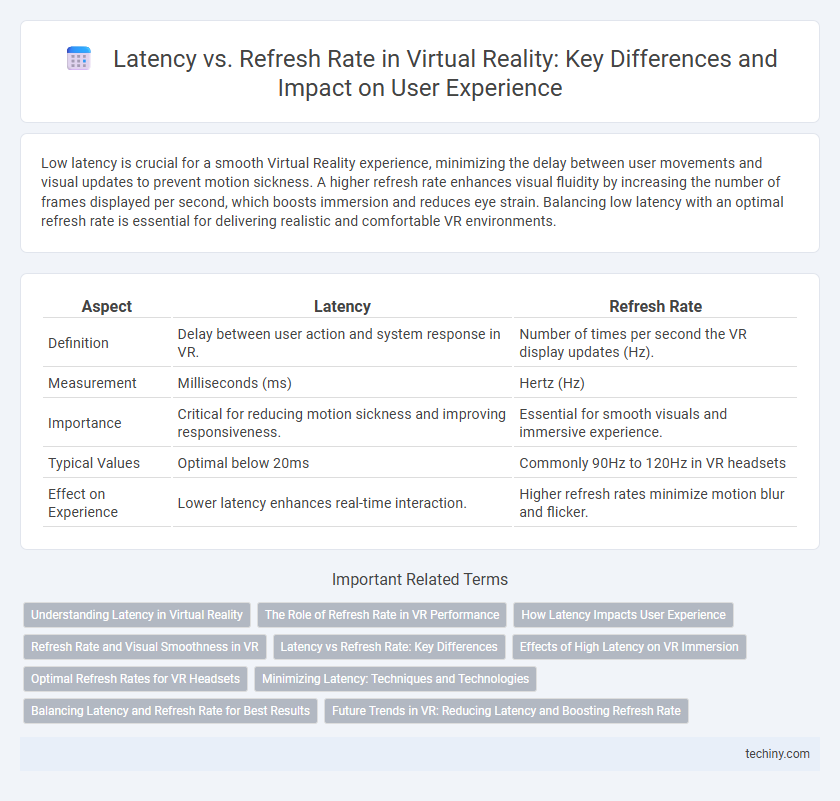Low latency is crucial for a smooth Virtual Reality experience, minimizing the delay between user movements and visual updates to prevent motion sickness. A higher refresh rate enhances visual fluidity by increasing the number of frames displayed per second, which boosts immersion and reduces eye strain. Balancing low latency with an optimal refresh rate is essential for delivering realistic and comfortable VR environments.
Table of Comparison
| Aspect | Latency | Refresh Rate |
|---|---|---|
| Definition | Delay between user action and system response in VR. | Number of times per second the VR display updates (Hz). |
| Measurement | Milliseconds (ms) | Hertz (Hz) |
| Importance | Critical for reducing motion sickness and improving responsiveness. | Essential for smooth visuals and immersive experience. |
| Typical Values | Optimal below 20ms | Commonly 90Hz to 120Hz in VR headsets |
| Effect on Experience | Lower latency enhances real-time interaction. | Higher refresh rates minimize motion blur and flicker. |
Understanding Latency in Virtual Reality
Latency in virtual reality refers to the time delay between a user's movement and the corresponding update on the VR display, critically impacting immersion and user comfort. High latency causes motion sickness and breaks the sense of presence by creating a noticeable lag between actions and visual feedback. Reducing latency below 20 milliseconds and optimizing refresh rates to 90 Hz or higher ensures seamless interaction and smooth experiences in VR environments.
The Role of Refresh Rate in VR Performance
Higher refresh rates in virtual reality (VR) significantly enhance visual smoothness and reduce motion blur, leading to a more immersive experience. A VR headset with a refresh rate of 90 Hz or above minimizes latency-induced discomfort and motion sickness by updating images more frequently, ensuring seamless tracking of head movements. Optimizing refresh rate is crucial in VR performance to maintain user engagement and prevent disorientation during fast-paced scenarios.
How Latency Impacts User Experience
Latency in virtual reality significantly affects user experience by causing motion sickness and reducing immersion when delays exceed 20 milliseconds. High latency disrupts the synchronization between user movements and visual updates, leading to a disorienting lag that hampers interaction fluidity. Optimal VR systems maintain latency under 20 ms alongside refresh rates of 90 Hz or higher to ensure smooth, realistic environments and user comfort.
Refresh Rate and Visual Smoothness in VR
High refresh rates in virtual reality significantly enhance visual smoothness by reducing motion blur and minimizing screen tearing, leading to a more immersive experience. Refresh rates of 90Hz or above are essential for VR headsets to ensure fluid motion rendering and prevent motion sickness. Optimizing refresh rate directly impacts latency perception, creating seamless interactions and improving user comfort during extended VR sessions.
Latency vs Refresh Rate: Key Differences
Latency measures the delay between a user's action and the VR system's response, critical for preventing motion sickness and ensuring immersion. Refresh rate refers to how many times per second the display updates, impacting the fluidity and clarity of visuals. Low latency combined with high refresh rates enhances user experience by delivering seamless and responsive virtual environments.
Effects of High Latency on VR Immersion
High latency in virtual reality disrupts the synchronization between user movements and visual updates, causing motion sickness and breaking immersion. A low refresh rate exacerbates this issue by producing sluggish frame transitions that heighten disorientation and reduce realism. Maintaining minimal latency and high refresh rates is essential for seamless VR experiences that preserve user comfort and engagement.
Optimal Refresh Rates for VR Headsets
Optimal refresh rates for VR headsets typically range between 90Hz and 120Hz to minimize motion sickness and enhance immersion. Lower latency combined with higher refresh rates reduces motion blur and latency-induced discomfort, ensuring smooth and responsive virtual experiences. Advanced VR systems prioritize 120Hz or higher to deliver crisp visuals and maintain user comfort during extended use.
Minimizing Latency: Techniques and Technologies
Minimizing latency in virtual reality is crucial for enhancing user immersion and reducing motion sickness, achieved through techniques such as asynchronous reprojection, time warp, and foveated rendering. Advanced hardware technologies like high-frequency OLED displays and low-persistence pixels contribute to faster refresh rates, directly lowering input lag and display latency. Integration of predictive tracking algorithms and edge computing further optimizes real-time responsiveness, ensuring seamless interaction within VR environments.
Balancing Latency and Refresh Rate for Best Results
Balancing latency and refresh rate is crucial for an immersive virtual reality experience, as low latency minimizes motion sickness and enhances responsiveness while a high refresh rate ensures smooth and fluid visuals. Achieving optimal results requires a refresh rate of at least 90Hz combined with latency below 20 milliseconds to maintain user comfort and realism. Hardware components like high-performance GPUs and optimized display panels are essential to meet these performance benchmarks without compromising VR content quality.
Future Trends in VR: Reducing Latency and Boosting Refresh Rate
Future trends in virtual reality emphasize reducing latency to under 10 milliseconds to achieve seamless user immersion and prevent motion sickness. Innovations in display technology aim to increase refresh rates beyond 120Hz, enhancing visual fluidity and responsiveness. Emerging techniques like foveated rendering and 5G connectivity further support these advancements by optimizing data processing and transmission speeds.
Latency vs Refresh Rate Infographic

 techiny.com
techiny.com